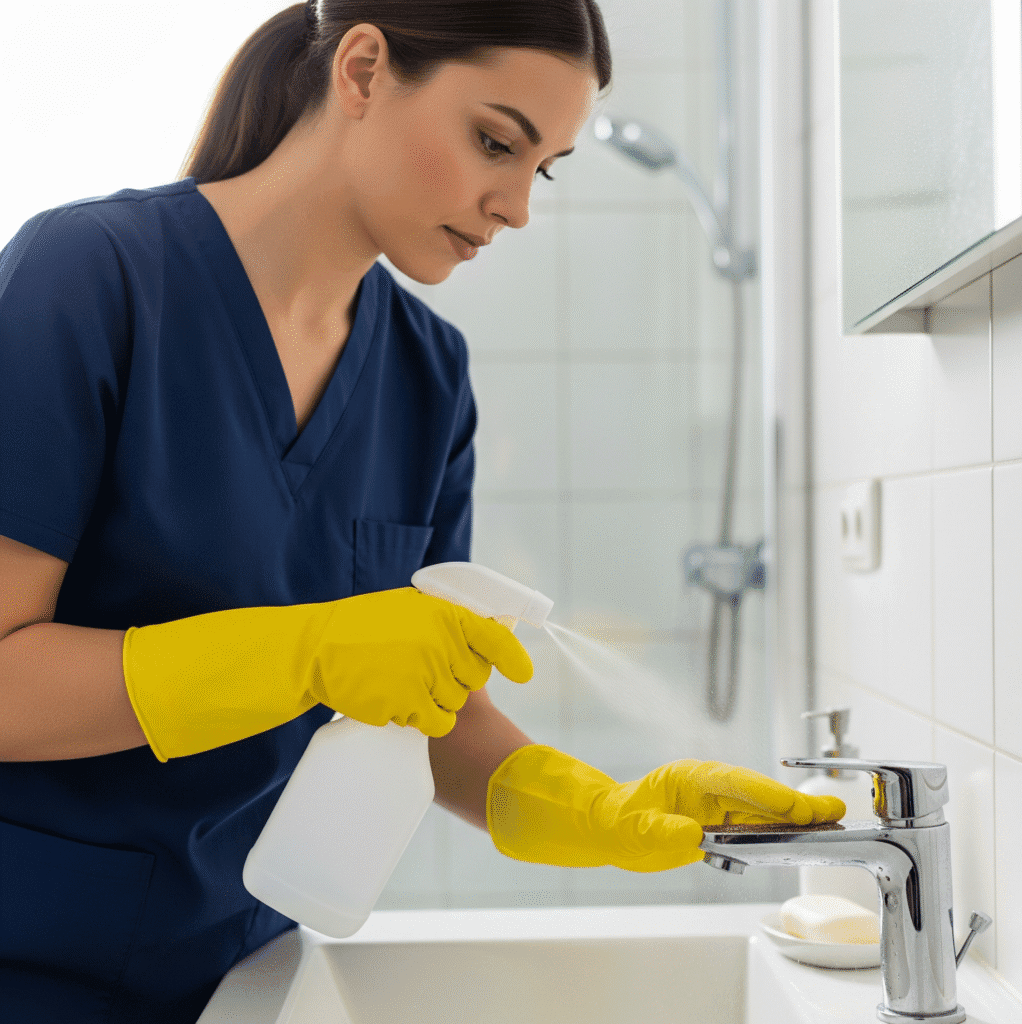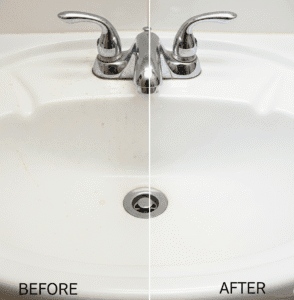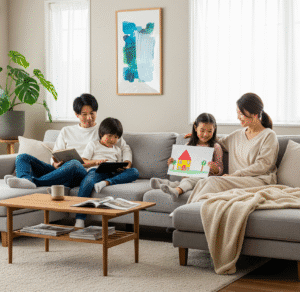
When it comes to keeping your home safe and healthy, you’ve probably heard the words disinfecting and sanitizing used interchangeably. But while both play a big role in cleanliness, they’re not the same. Knowing the difference can help you protect your family from germs while also keeping your home sparkling clean.
In this article, we’ll break down disinfecting vs sanitizing, where each is most effective, the right products to use, and why professional cleaners like Excellence Maids can take the guesswork out of it for you.
Sanitizing reduces the number of germs on surfaces to a safe level, according to public health standards. It doesn’t necessarily kill all germs, but it lowers the risk of spreading infection.
Disinfecting goes a step further. It kills nearly 100% of germs, viruses, and bacteria on a surface when used correctly with an EPA-registered disinfectant.
Think of it this way:
Sanitizing = making a surface “good enough” for everyday safety.
Disinfecting = a deeper, targeted kill of germs that cause illness.

Most people just say “cleaning” when they wipe a counter or spray a product. But a simple multi-surface cleaner is usually just removing dirt, not necessarily sanitizing or disinfecting.
This confusion often leads to:
Using the wrong product for the wrong job.
Thinking a pleasant-smelling cleaner is also killing germs (not always true).
Overusing harsh chemicals when they aren’t needed.
Sanitizing is ideal for surfaces that don’t typically harbor dangerous levels of bacteria but still benefit from routine cleaning.
Best places to sanitize regularly:
Kitchen counters after preparing food
Dining tables
Bathroom sinks and counters
Doorknobs, light switches, and handrails
Pro tip: Sanitizing wipes or sprays are quick for these areas, especially when used multiple times a day in high-traffic homes.
Disinfecting is essential in high-risk areas where harmful germs can spread illness.
Best places to disinfect:
Toilet handles and seats
Bathroom faucets and shower handles
Kitchen sinks and cutting boards (especially after raw meat)
Trash can lids
Frequently touched electronics (phones, tablets, remote controls)
If someone in the household is sick, you’ll want to disinfect frequently touched surfaces more often to prevent others from catching it.

Not every cleaning spray disinfects. To truly disinfect, you need an EPA-registered disinfectant. Common household options include:
Clorox Disinfecting Bleach – powerful, widely available, proven disinfectant (requires dilution).
Lysol Disinfectant Spray or Wipes – effective on most hard surfaces, ready to use.
Seventh Generation Disinfectant Spray – botanical-based, less harsh smell, ready to use.
Clorox Clean-Up Cleaner + Bleach – cleans and disinfects in one, convenient for bathrooms/kitchens.
Always check the label: the product should specifically state that it kills 99.9% of viruses and bacteria and carry an EPA registration number.
Not following dwell time – Spraying and wiping too quickly means germs aren’t fully killed. Many disinfectants need to stay wet for 5–10 minutes.
Mixing cleaners – Combining bleach with ammonia (like glass cleaner) or vinegar is dangerous.
Using too much bleach – Overdiluting reduces effectiveness, while underdiluting can damage surfaces.
Relying only on “good smells” – A fresh scent doesn’t equal germ-free.
Even with the right products at home, many homeowners don’t have the time to disinfect properly. That’s where professional cleaners come in.
At Excellence Maids, our team uses EPA-approved disinfectants in high-risk areas and combines them with thorough sanitizing practices for the rest of the home. The result is not just a clean-looking house but one that truly supports a healthy environment.
Whether you need a one-time Deep Cleaning service to reset your home or a Recurring Cleaning service for ongoing maintenance, we tailor our approach to make sure every surface gets the right treatment.
Your kitchen is the heart of your home—and a hot spot for bacteria.
Sanitize counters and tables after everyday use.
Disinfect sinks, cutting boards, and areas exposed to raw meat or fish.
Avoid harsh bleach directly on food-contact surfaces unless you rinse thoroughly.
Bathrooms are where disinfecting is most crucial.
Disinfect toilets, faucets, and shower handles daily.
Sanitize mirrors, counters, and towel racks regularly.
Use a fresh-smelling multi-surface cleaner (like Fabuloso or Method) after disinfecting to reduce bleach odor.

Yes, each has a purpose. Sanitizing is best for everyday upkeep, while disinfecting is your shield against germs that cause illness. Together, they create the balance of a safe, welcoming, and healthy home.
At Excellence Maids:
We use EPA-approved disinfectants for high-touch, high-risk surfaces.
We sanitize daily-use areas to keep them fresh and safe.
We avoid mixing harsh chemicals, keeping your home safe from harmful fumes.
We finish with fresh-smelling cleaners so your home feels as good as it looks.
Understanding the difference between disinfecting vs sanitizing helps homeowners make smarter cleaning choices. While sanitizing handles everyday messes, disinfecting is the key to stopping germs in their tracks.
For busy families in Coral Springs and nearby neighborhoods, hiring a trusted, licensed cleaning service like Excellence Maids ensures your home gets the right balance of both—without the stress or guesswork.

✨ Your clean home is one click away.
Get an estimate in under 60 seconds — no calls, no hassle.






Copyright © 2024 Excellence Maids Cleaning Services – All Rights Reserved